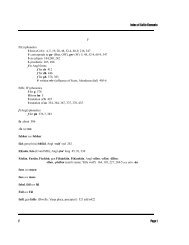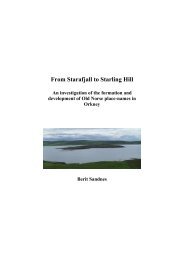May Williamson: The Non-Celtic Place-Names of the Scottish Border ...
May Williamson: The Non-Celtic Place-Names of the Scottish Border ...
May Williamson: The Non-Celtic Place-Names of the Scottish Border ...
You also want an ePaper? Increase the reach of your titles
YUMPU automatically turns print PDFs into web optimized ePapers that Google loves.
94<br />
LSMM. <strong>The</strong>y exhibit <strong>the</strong> early ME forms <strong>of</strong> cleuch. <strong>The</strong>se are valleys in <strong>the</strong> Lammermoors.<br />
<strong>The</strong> first may be in ELth.<br />
<strong>The</strong>re are no examples <strong>of</strong> names ending in -clo, or -clow, in <strong>the</strong>ir modern forms, although<br />
names in OE -hōh frequently have present-day forms in -ho, -how: cf Fogo, Kelso, Chatto.<br />
Forms in -heugh are to be found in names <strong>of</strong> more recent origin, <strong>the</strong>refore it must be<br />
concluded that names in -cleuch are unlikely to be pre-Middle English.<br />
<strong>The</strong>re are 22 names in -cleuch in Rxb, for which no early spellings have been found, 6 in<br />
Bwk, 25 in Dmf, and 17 in Slk.<br />
/234/ LXII OE hol,<br />
as an ending, is usually coupled with <strong>the</strong> name <strong>of</strong> an animal. Brock, “badger”, is <strong>the</strong> first<br />
element in Brockholes (Cld): Brokholl, 1415 Cold, Brokholes, 1426 ib; in Brocklehirst<br />
(Msw): Brokholhirst, Blaeu; in Brocklerig (St M): Brockholrig, Blaeu. ModSc tod, “fox”,<br />
occurs in Todholes (Kcl), so spelt in 1586 CBP. ON refr, also meaning “fox”, is found in<br />
Raffles (Msw): Refholes, 1215-45 CDS; R<strong>of</strong>fals, Blaeu; Raffels, 1659 Reg Sas Dmf: cf<br />
Reagill, We (DEPN, 364) and a lost field-name Refholeslac, c 1210 (PN YER, 329). In a few<br />
cases hol denotes “hollow”, as in Pinglehole (Cst): Pingill Holls, Blaeu, <strong>the</strong> first element <strong>of</strong><br />
which may be ModSc pingle, “a small pan” (Watson, s.v.), in <strong>the</strong> sense <strong>of</strong> “pot-shaped<br />
hollow”; compare, however, No LVII (h). In Bucklerhole (Lmb): Buklerhol, Blaeu, <strong>the</strong> sense<br />
is obscure.<br />
O<strong>the</strong>r names in -hole are:<br />
Cribbs Hole (Sdn); Muttonhole (Mxt), a common field-name in Sou<strong>the</strong>rn Scotland;<br />
Nickieshole (How); Scrathy Holes (Sdn), which may contain ON skratti, “goblin”: cf<br />
Scrathawe, 1400 (PN Nth, 264); Hawkshole (Can); Paddockhole (Tun); White Hole Burn<br />
(Esk); Wyliehole (Tun).<br />
/235/ LXIII<br />
Miscellaneous endings denoting valleys, passes, etc.<br />
(a)<br />
(b)<br />
(c)<br />
OE swīra, “neck”, gives ModSc swire, “a pass”. <strong>The</strong> Redeswire Fray (Sdn), <strong>the</strong><br />
scene <strong>of</strong> a battle, is Rusdwire, 1343 Fine (with meta<strong>the</strong>sis <strong>of</strong> s and d); Redis Swyr,<br />
c 1375 (c 1490) Brus; Reidswyre, 1576 CSP (Th). <strong>The</strong> first element might be ON<br />
rauðr, “red”, later equated with MSc reid. <strong>The</strong>re is also Swyre (Dns).<br />
OE dor, “door”, used in <strong>the</strong> sense <strong>of</strong> “pass”, is <strong>the</strong> terminal <strong>of</strong> Windydoors (Cad):<br />
Windesdores, c 1155 (16 th ) Dryb; Wyndiduris, 1455 Rot Scac; Windidurris, 1510<br />
HMC (Wed). Comparable formations are Windygates (Fife), and Wingate,<br />
Wingates, Nb (PN NbDu, 217).<br />
Nick, “a hollow or pass between hills”, is found in Sou<strong>the</strong>rly Nick (Cad), Peelnick<br />
(Oxn), and Wallacenick (Kso).




